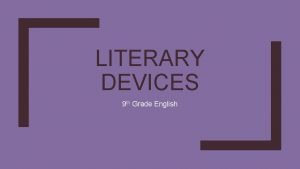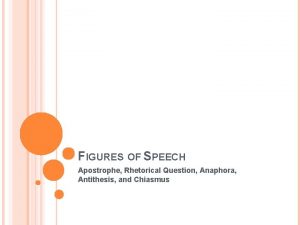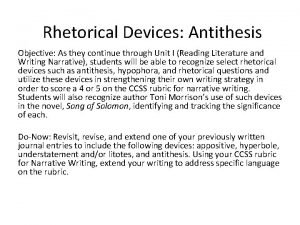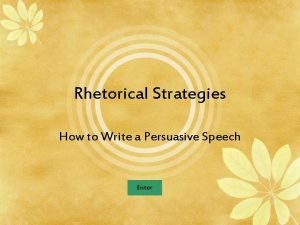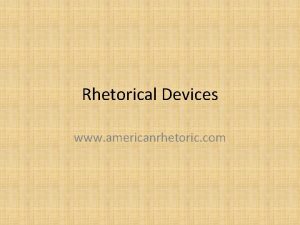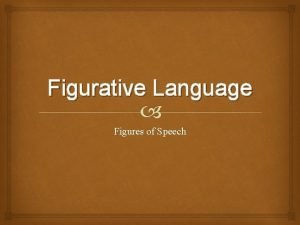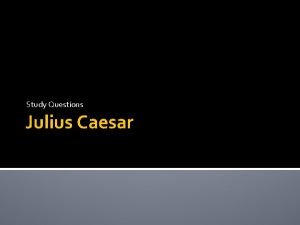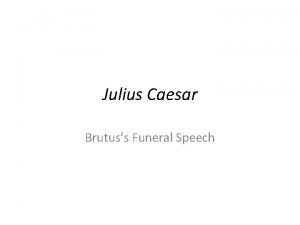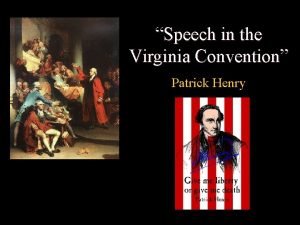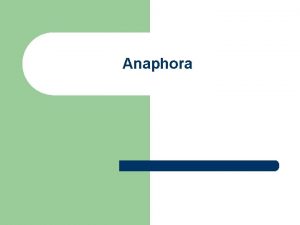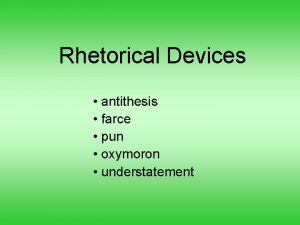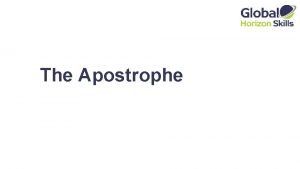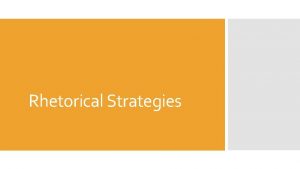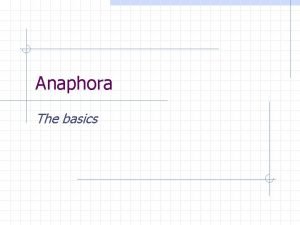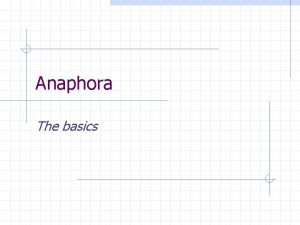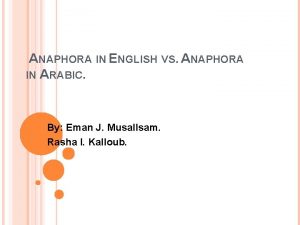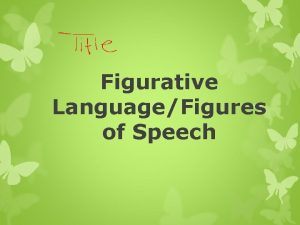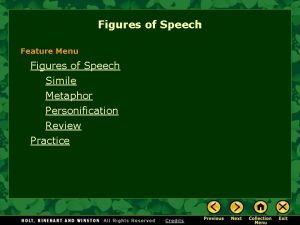FIGURES OF SPEECH Apostrophe Rhetorical Question Anaphora Antithesis










- Slides: 10

FIGURES OF SPEECH Apostrophe, Rhetorical Question, Anaphora, Antithesis, and Chiasmus

FIGURES OF SPEECH (SCHEMES) Depend upon a change in the standard order or usual syntax of words to create special effects. The term “figures of speech” is sometimes used to refer to the much broader category of tropes, which depends on changes not in the order to syntax, but in standard meanings of words. More specifically, it describes a smaller category of rhetorical figures, including: APOSTROPHE, RHETORICAL QUESTION, ANAPHORA, ANTITHESIS, and CHIASMUS.

APOSTROPHE An address to a dead or absent person or to an inanimate object or abstract concept. The aim is not, of course, to evoke a response—a logical impossibility—but to elevate the style or to give emotional intensity to the address. EXAMPLE: In Shakespeare’s Romeo & Juliet, the young heroine, awaiting the consummation of her marriage with Romeo, apostrophizes a personification of night to guide her through the thrilling and intimidating experience: “Come, civil, night, / Thou sobersuited matron all in black, / And learn me how to lose a winning match, / Played for a pair of stainless maidenhoods. ”

INVOCATION A special form of apostrophe in which the poet addresses an appeal to a muse or a god to inspire the creative endeavor. EXAMPLE: Such epic poems as Homer’s Odyssey begin with an invocation: “Sing in me, Muse, and through me tell the story / of that man skilled in all ways of contending. ”

RHETORICAL QUESTION A figure of speech in which a question is posed not to solicit a reply but to emphasize a foregone or clearly implied conclusion. The goal is to create a stronger effect than might be achieved by a direct assertion. EXAMPLE: William Blake’s “Holy Thursday (II)” is a blistering denouncement of the suffering imposed on poor children in the charity schools of eighteenth century England. The narrator expresses his outrage in a series of rhetorical questions.

“HOLY THURSDAY (II)” BY WILLIAM BLAKE Is this a holy thing to see In a rich and fruitful land, Babes reduced to misery, Fed with cold and usurous hand? Is that trembling cry a song? Can it be a song of joy? And so many children poor?

ANAPHORA An intentional repetition of words or phrases at the beginning of successive lines, stanzas, sentences, or paragraphs. Used frequently in both poetry and prose to create emphasis, though the effect differs with the context. EXAMPLE Walt Whitman’s “Song of Myself” is replete with anaphora. One example is the narrator’s response to a child’s question— “What is the grass? ”—which he answers with a series of whimsical proposals, all of which contain the phrase “I guess”: “I guess it must be the flag of my disposition, out of hopeful green stuff woven. / Or I guess it is the handkerchief of the Lord. ” The effect is soothing rhythmic harmony. In contrast, in “The Charge of the Light Brigade, ” Tennyson uses anaphora to suggest the speech and tension of a fatal battle: “Cannon to the right of them, / Cannon to the left of them, / Cannon in front of them / Volleyed and thundered. ”

ANTITHESIS From the Greek word for “opposition” is a figure of speech in which words or phrases that are parallel in order and syntax express opposite or contrasting meanings. EXAMPLE The long opening sentence of Charles Dickens’s A Tale of Two Cities provides a famous series of antithesis: “It was the best of times, it was the worst of times, it was the age of wisdom, it was the age of foolishness, it was the epoch of belief, it was the epoch of incredulity, it was the season of Light, it was the season of Darkness…”

CHIASMUS A figure of speech in which two successive phrases or clauses are parallel in syntax but reverse the order of the analogous words. EXAMPLE Robert Frost’s “The Gift Outright” begins with the chiastic line: “The land was ours before we were the land’s. ” The pattern of noun, verb, possessive pronoun of the first clause becomes that of pronoun, verb, possessive noun the second; the figure suggests the connection between American’s colonization of their new country and the need to prove their claim to it by “the gift outright” of fervent acts of patriotism.

RESOURCES Hamilton, Sharon. Essential Literary Terms. New York: People’s Education, 2007.
 Whats an extended metaphor
Whats an extended metaphor Figures of speech apostrophe
Figures of speech apostrophe Antithesis purpose
Antithesis purpose Antithesis rhetorical definition
Antithesis rhetorical definition Antithesis examples
Antithesis examples Figure of speech in london 1802
Figure of speech in london 1802 Why do the conspirators plant papers on brutus’s chair?
Why do the conspirators plant papers on brutus’s chair? Brutus oration
Brutus oration Patrick henry speech rhetorical devices
Patrick henry speech rhetorical devices Rhetorical choices
Rhetorical choices What is a level 1 question
What is a level 1 question
